All-Optical Formation and Manipulation of Microbubbles on a Porous Gold Nanofilm
Abstract
1. Introduction
2. Materials and Methods
2.1. Sample Preparation
2.2. Experimental Setup
2.3. Simulation of Electromagnetic Field Enhancement
3. Results and Discussion
3.1. Plasmonic Enhancement of the Porous Au Nanofilm
3.2. Dynamic Process of Microbubble Formation and Shrinkage
3.3. Formation of Microbubble Patterns with Multiple Microbubbles
3.4. Optical Movement and Fusion of Microbubbles
4. Conclusions
Supplementary Materials
Author Contributions
Funding
Acknowledgments
Conflicts of Interest
References
- Yang, K.; Zhou, Y.; Ren, Q.; Ye, J.; Deng, C. Dynamics of Microbubble Generation and Trapping by Self-Focused Femtosecond Laser Pulses. Appl. Phys. Lett. 2009, 95, 51107. [Google Scholar] [CrossRef]
- Ortega-Mendoza, J.G.; Sarabia-Alonso, J.A.; Zaca-Morán, P.; Padilla-Vivanco, A.; Toxqui-Quitl, C.; Rivas-Cambero, I.; Ramirez-Ramirez, J.; Torres-Hurtado, S.A.; Ramos-García, R.M. Force-Driven Manipulation of Photothermally-Induced Microbubbles. Opt. Express 2018, 26, 6653–6662. [Google Scholar] [CrossRef] [PubMed]
- Xu, R.; Xin, H.; Li, Q.; Yang, X.; Chen, H.; Li, B. Photothermal Formation and Targeted Positioning of Bubbles by a Fiber Taper. Appl. Phys. Lett. 2012, 101, 54103. [Google Scholar] [CrossRef]
- Lohse, D.; Zhang, X. Surface Nanobubbles and Nanodroplets. Rev. Mod. Phys. 2015, 87, 981–1035. [Google Scholar] [CrossRef]
- Kim, H.; Lee, H.; Moon, H.; Kang, J.; Jang, Y.; Kim, D.; Kim, J.; Huynh, E.; Zheng, G.; Kim, H.; et al. Resonance-Based Frequency-Selective Amplification for Increased Photoacoustic Imaging Sensitivity. ACS Photonics 2019, 6, 2268–2276. [Google Scholar] [CrossRef]
- Li, Y.; Xin, H.; Zhang, Y.; Lei, H.; Zhang, T.; Ye, H.; Saenz, J.J.; Qiu, C.; Li, B. Living Nanospear for Near-Field Optical Probing. ACS Nano 2018, 12, 10703–10711. [Google Scholar] [CrossRef]
- Lukianova-Hleb, E.Y.; Kim, Y.; Belatsarkouski, I.; Gillenwater, A.M.; O’Neill, B.E.; Lapotko, D.O. Intraoperative Diagnostics and Elimination of Residual Microtumours with Plasmonic Nanobubbles. Nat. Nanotechnol. 2016, 11, 525–532. [Google Scholar] [CrossRef]
- Shao, J.; Xuan, M.; Dai, L.; Si, T.; Li, J.; He, Q. Near-Infrared-Activated Nanocalorifiers in Microcapsules: Vapor Bubble Generation for In Vivo Enhanced Cancer Therapy. Angew. Chem. Int. Ed. 2015, 54, 2782–12787. [Google Scholar] [CrossRef]
- Sun, S.; Sun, S.; Sun, Y.; Wang, P.; Zhang, J.; Du, W.; Wang, S.; Liang, X. Bubble-Manipulated Local Drug Release from a Smart Thermosensitive Cerasome for Dual-Mode Imaging Guided Tumor Chemo-Photothermal Therapy. Theranostics 2019, 9, 8138–8154. [Google Scholar] [CrossRef]
- Boutopoulos, C.; Bergeron, E.; Meunier, M. Cell Perforation Mediated by Plasmonic Bubbles Generated by a Single Near Infrared Femtosecond Laser Pulse. J. Biophotonics 2016, 9, 26–31. [Google Scholar] [CrossRef]
- Xin, H.; Li, Y.; Xu, D.; Zhang, Y.; Chen, C.; Li, B. Single Upconversion Nanoparticle-Bacterium Cotrapping for Single-Bacterium Labeling and Analysis. Small 2017, 13, 1603418. [Google Scholar] [CrossRef] [PubMed]
- Shi, A.; Min, Y.; Wan, M. Flowing Microbubble Manipulation in Blood Vessel Phantom Using Ultrasonic Standing Wave with Stepwise Frequency. Appl. Phys. Lett. 2013, 103, 174105. [Google Scholar] [CrossRef]
- Ahmed, D.; Ozcelik, A.; Bojanala, N.; Nama, N.; Upadhyay, A.; Chen, Y.; Hanna-Rose, W.; Huang, T. Rotational Manipulation of Single Cells and Organisms Using Acoustic Waves. Nat. Commun. 2016, 7, 11085. [Google Scholar] [CrossRef] [PubMed]
- Zhang, C.; Wang, Y.; Gong, Y.; Wu, Y.; Peng, G.; Rao, Y. The Generation and Assembly of Laser-Induced Microbubbles. J. Lightwave Technol. 2018, 36, 2492–2498. [Google Scholar] [CrossRef]
- Errico, C.; Pierre, J.; Pezet, S.; Desailly, Y.; Lenkei, Z.; Couture, O.; Tanter, M. Ultrafast Ultrasound Localization Microscopy for Deep Super-Resolution Vascular Imaging. Nature 2015, 527, 499–502. [Google Scholar] [CrossRef]
- Prentice, P.A.; MacDonald, M.P.; Frank, T.G.; Cuschieri, A.; Spalding, G.C.; Sibbett, W.; Campbell, P.A.; Dholakia, K. Manipulation and Filtration of Low Index Particles with Holographic Laguerre-Gaussian Optical Trap Arrays. Opt. Express 2004, 12, 593–600. [Google Scholar] [CrossRef]
- Jones, P.H.; Stride, E.; Saffari, N. Trapping and Manipulation of Microscopic Bubbles with a Scanning Optical Tweezer. Appl. Phys. Lett. 2006, 89, 081113. [Google Scholar] [CrossRef]
- Hartland, G.V. Optical Studies of Dynamics in Noble Metal Nanostructures. Chem. Rev. 2011, 111, 3858–3887. [Google Scholar] [CrossRef]
- Lukianova-Hleb, E.; Hu, Y.; Latterini, L.; Tarpani, L.; Lee, S.; Drezek, R.A.; Hafner, J.H.; Lapotko, D.O. Plasmonic Nanobubbles as Transient Vapor Nanobubbles Generated around Plasmonic Nanoparticles. ACS Nano 2010, 4, 2109–2123. [Google Scholar] [CrossRef]
- Kasani, S.; Curtin, K.; Wu, N. A Review of 2D and 3D Plasmonic Nanostructure Array Patterns: Fabrication, Light Management and Sensing Applications. Nanophotonics 2019, 8, 2065–2089. [Google Scholar] [CrossRef]
- Baffou, G.; Berto, P.; Bermúdez, U.E.; Quidant, R.; Monneret, S.; Polleux, J.; Rigneault, H. Photoinduced Heating of Nanoparticle Arrays. ACS Nano 2013, 7, 6478–6488. [Google Scholar] [CrossRef] [PubMed]
- Fang, Z.; Zhen, Y.R.; Neumann, O.; Polman, A.; García, D.A.F.J.; Nordlander, P.; Halas, N.J. Evolution of Light-Induced Vapor Generation at a Liquid-Immersed Metallic Nanoparticle. Nano Lett. 2013, 13, 1736–1742. [Google Scholar] [CrossRef] [PubMed]
- Baffou, G.; Polleux, J.; Rigneault, H.; Monneret, S. Super-Heating and Micro-Bubble Generation around Plasmonic Nanoparticles under cw Illumination. J. Phys. Chem. C. 2014, 118, 4890–4898. [Google Scholar] [CrossRef]
- Neumann, O.; Urban, A.S.; Day, J.; Lal, S.; Nordlander, P.; Halas, N.J. Solar Vapor Gen eration Enabled by Nanoparticles. ACS Nano 2012, 7, 42–49. [Google Scholar] [CrossRef]
- Xie, Y.; Zhao, C. An Optothermally Generated Surface Bubble and Its Applications. Nanoscale 2017, 9, 6622–6631. [Google Scholar] [CrossRef]
- Zhao, C.; Liu, Y.; Zhao, Y.; Fang, N.; Huang, J.T. A Reconfigurable Plasmofluidic Lens. Nat. Commun. 2013, 4, 2305. [Google Scholar] [CrossRef]
- Chen, J.; Kang, Z.; Wang, G.; Loo, J.F.C.; Kong, S.K.; Ho, H. Optofluidic Guiding, Valving, Switching and Mixing Based on Plasmonic Heating in a Random Gold Nanoisland Substrate. Lab Chip 2015, 15, 2504–2512. [Google Scholar] [CrossRef]
- Li, J.; Zhao, F.; Deng, Y.; Liu, D.; Chen, C.; Shih, W. Photothermal Generation of Programmable Microbubble Array on Nanoporous Gold Disks. Opt. Express 2018, 26, 16893–16902. [Google Scholar] [CrossRef]
- Li, Y.; Liu, X.; Yang, X.; Lei, H.; Zhang, Y.; Li, B. Enhancing Upconversion Fluorescence with a Natural Bio-microlens. ACS Nano 2017, 11, 10672–10680. [Google Scholar] [CrossRef]
- Lin, L.; Peng, X.; Mao, Z.; Li, W.; Yogeesh, M.N.; Rajeeva, B.B.; Perillo, E.P.; Dunn, A.K.; Akinwande, D.; Zheng, Y. Bubble-Pen Lithography. Nano Lett. 2015, 16, 701–708. [Google Scholar] [CrossRef]
- Setoura, K.; Ito, S.; Miyasaka, H. Stationary Bubble Formation and Marangoni Convection Induced by CW Laser Heating of a Single Gold Nanoparticle. Nanoscale 2017, 9, 719–730. [Google Scholar] [CrossRef] [PubMed]
- Johnson, P.B.; Christy, R.W. Optical Constants of the Noble Metals. Phys. Rev. B 1972, 6, 4370–4379. [Google Scholar] [CrossRef]
- Palik, E.D. Handbook of Optical Constants of Solids; Academic Press: Orlando, FL, USA, 1998; Volume 3. [Google Scholar]
- Roy, B.; Arya, M.; Thomas, P.; Jürgschat, J.K.; Venkata, R.K.; Banerjee, A.; Malla, R.C.; Roy, S. Self-Assembly of Mesoscopic Materials to Form Controlled and Continuous Patterns by Thermo-Optically Manipulated Laser Induced Microbubbles. Langmuir 2013, 29, 14733–14742. [Google Scholar] [CrossRef] [PubMed]
- Bangalore, R.B.; Lin, L.; Perillo, E.P.; Peng, X.; Yu, W.W.; Dunn, A.K.; Zheng, Y. High-Resolution Bubble Printing of Quantum Dots. ACS Appl. Mater. Int. 2017, 9, 16725–16733. [Google Scholar] [CrossRef] [PubMed]
- Liu, X.; Bao, L.; Dipalo, M.; De, A.F.; Zhang, X. Formation and Dissolution of Microbubbles on Highly-Ordered Plasmonic Nanopillar Arrays. Sci. Rep. 2016, 5, 18515. [Google Scholar] [CrossRef] [PubMed]
- Angelsky, O.V.; Bekshaev, A.Y.; Maksimyak, P.P.; Maksimyak, A.P.; Hanson, S.G.; Kontush, S.M. Controllable Generation and Manipulation of Micro-Bubbles in Water with Absorptive Colloid Particles by CW Laser Radiation. Opt. Express 2017, 25, 5232–5243. [Google Scholar] [CrossRef]
- Wang, Y.; Zaytsev, M.E.; The, H.L.; Eijkel, J.C.T.; Zandvliet, H.J.W.; Zhang, X.; Lohse, D. Vapor and Gas-Bubble Growth Dynamics around Laser-Irradiated, Water-Immersed Plasmonic Nanoparticles. ACS Nano 2017, 11, 2045–2051. [Google Scholar] [CrossRef]
- Setoura, K.; Okada, Y.; Hashimoto, S. CW-Laser-Induced Morphological Changes of a Single Gold Nanoparticle on Glass: Observation of Surface Evaporation. Phys. Chem. Chem. Phys. 2014, 16, 26938–26945. [Google Scholar] [CrossRef]
- Li, Y.; Liu, X.; Li, B. Single-Cell Biomagnifier for Optical Nanoscopes and Nanotweezers. Light Sci. Appl. 2019, 8, 61. [Google Scholar] [CrossRef]
- Gao, D.; Ding, W.; Nieto-Vesperinas, M.; Ding, X.; Qiu, C.W. Optical manipulation from the microscale to the nanoscale: Fundamentals, advances and prospects. Light Sci. Appl. 2017, 6, e17039. [Google Scholar] [CrossRef]
- Li, Y.; Xin, H.; Lei, H.; Liu, L.; Li, Y.; Zhang, Y.; Li, B. Manipulation and detection of single nanoparticles and biomolecules by a photonic nanojet. Light Sci. Appl. 2016, 5, e16176. [Google Scholar] [CrossRef] [PubMed]
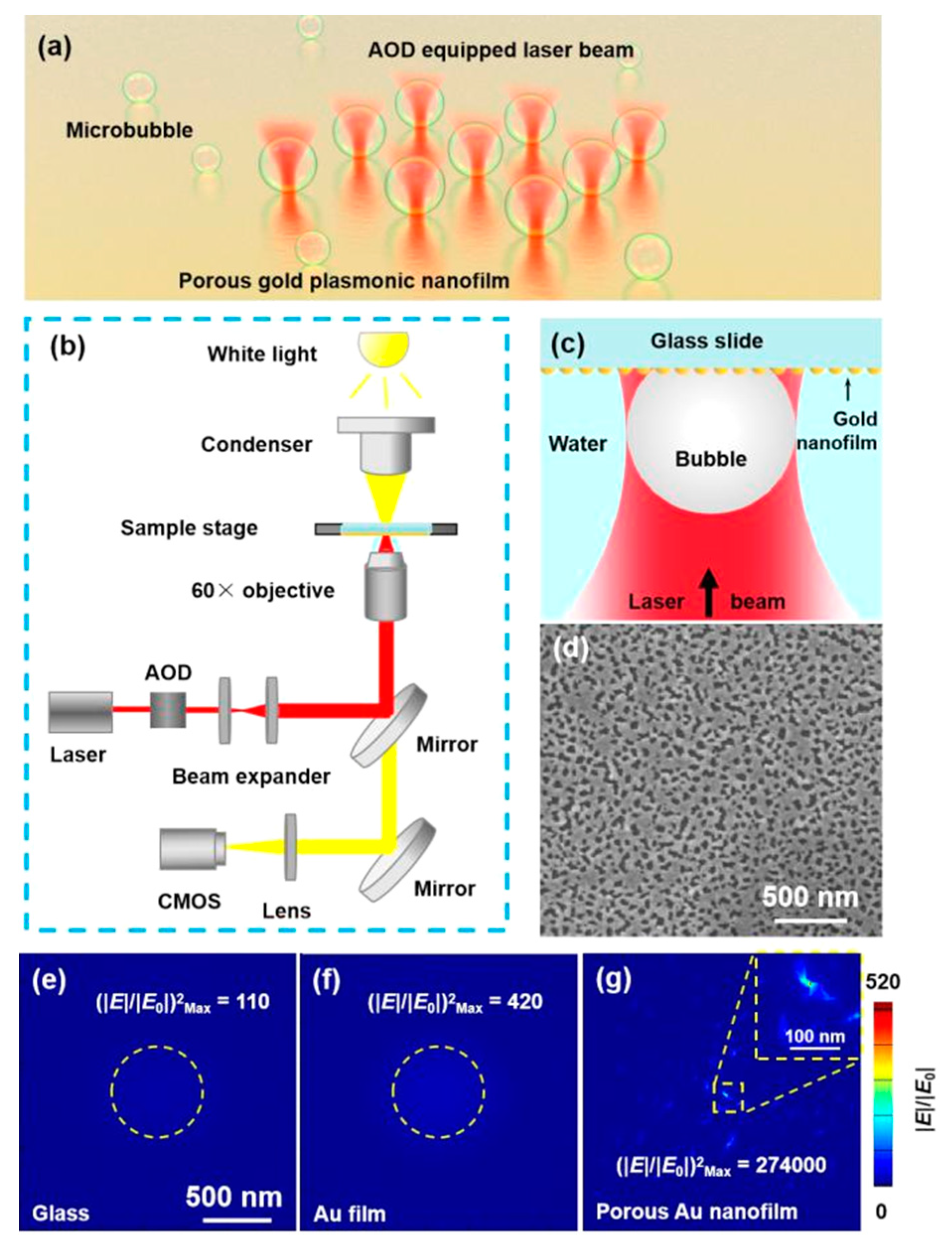
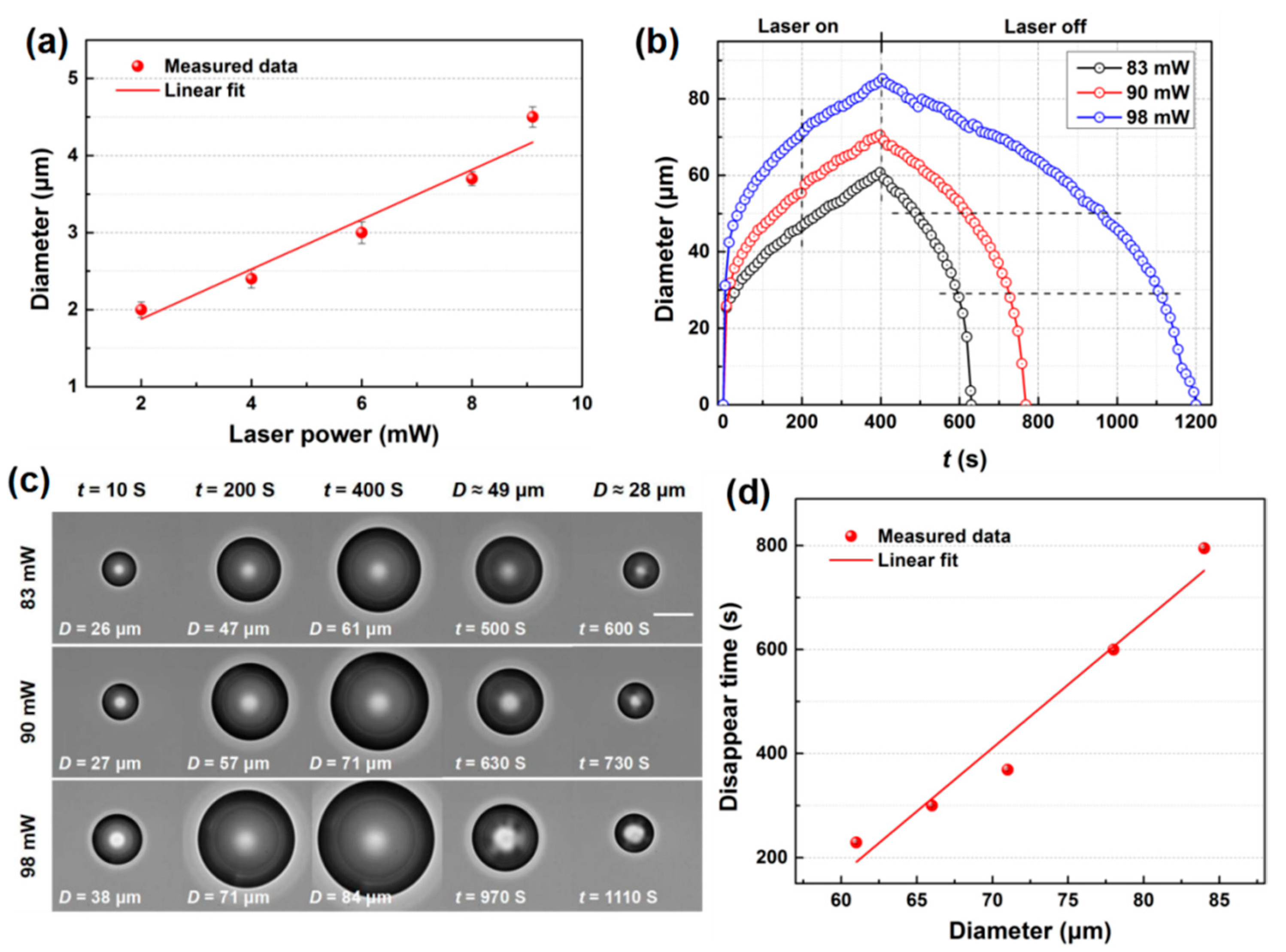
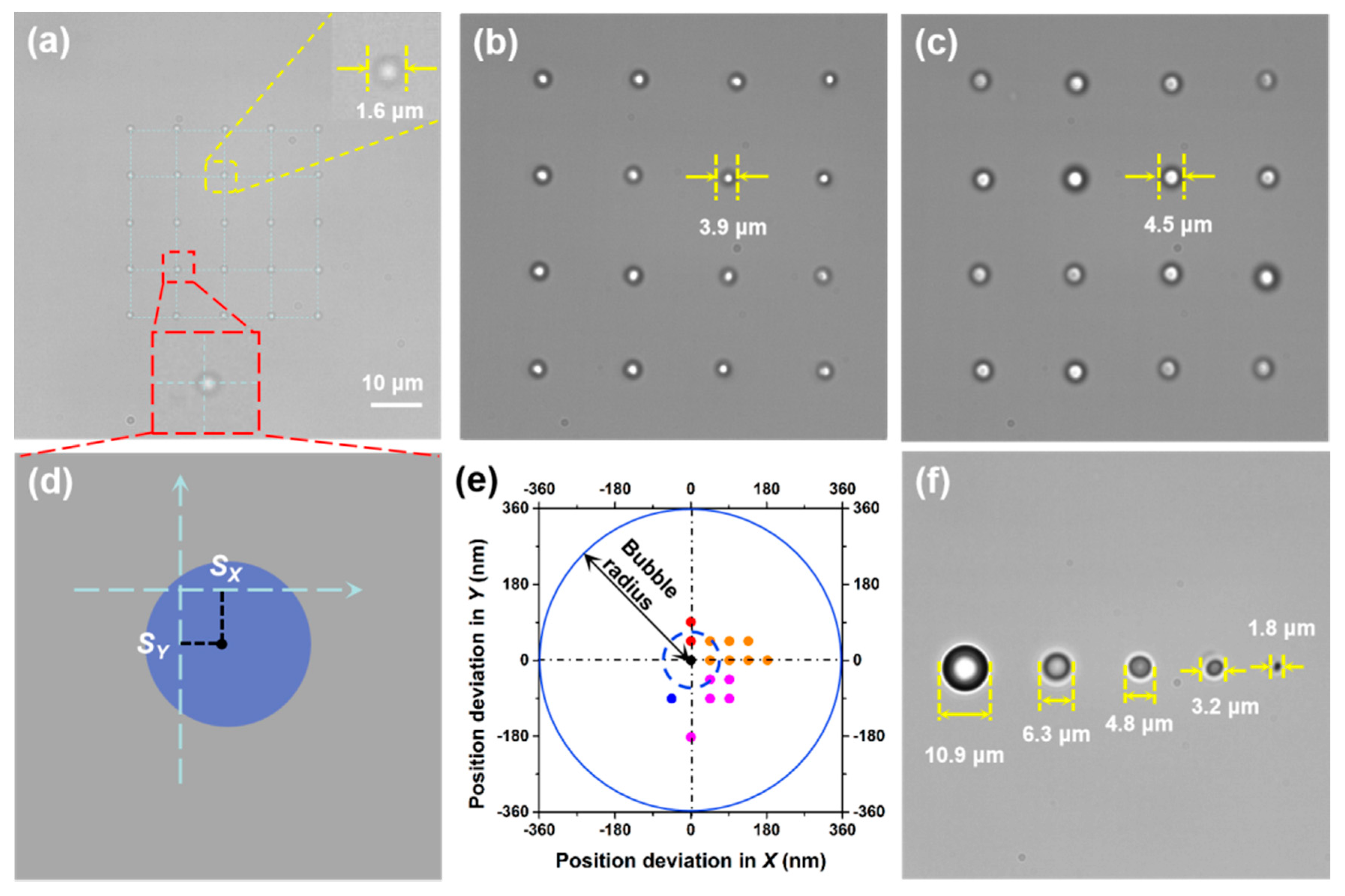
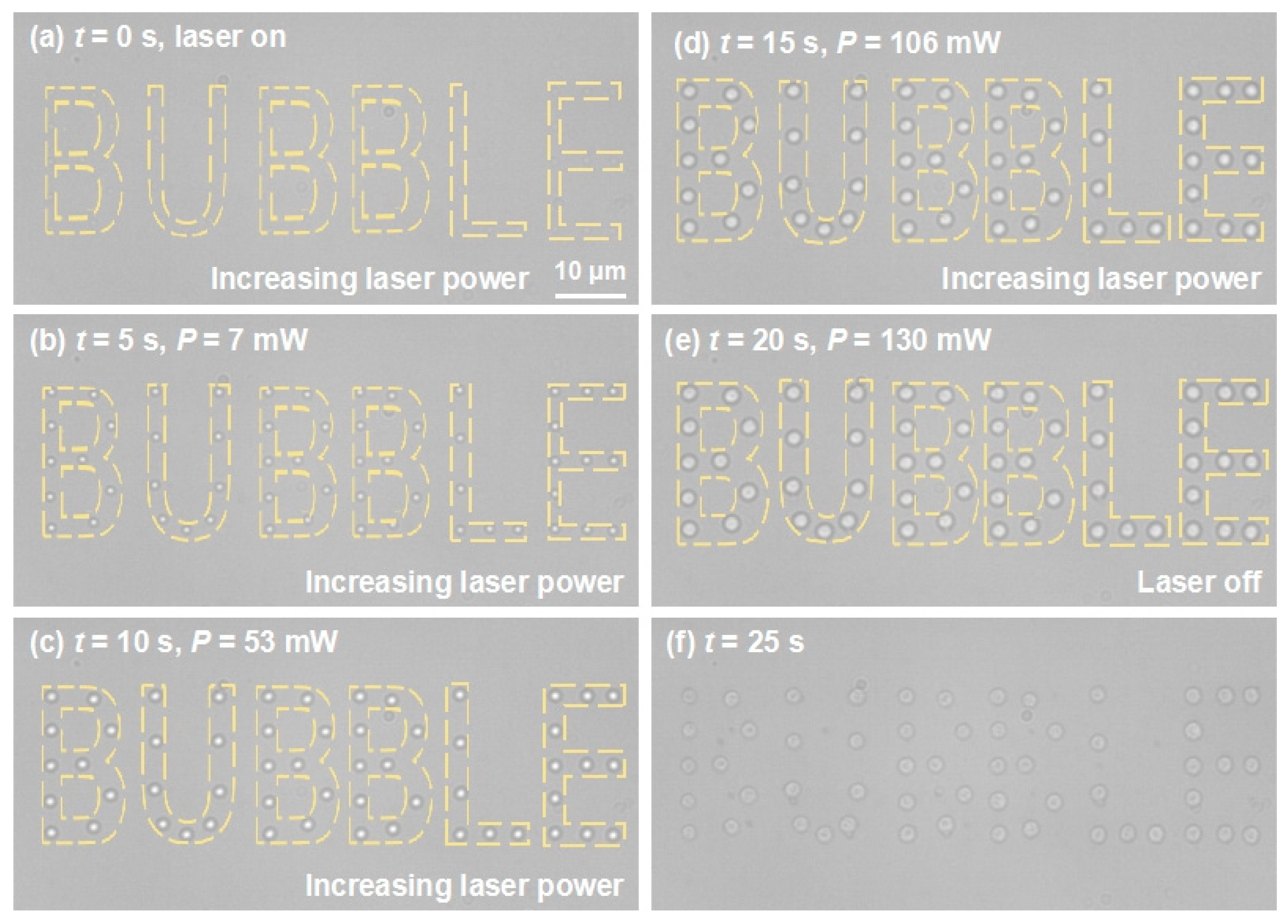
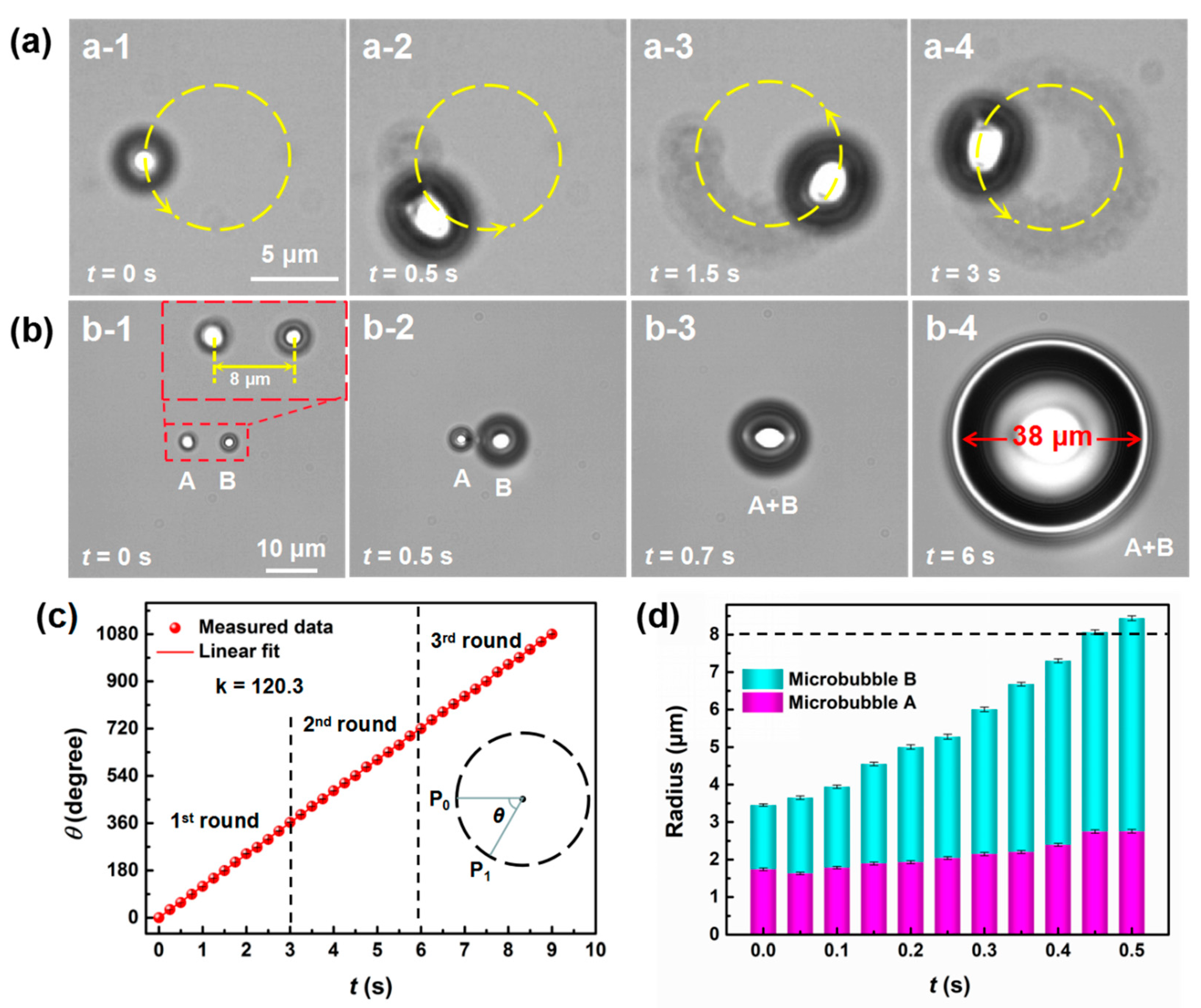
© 2020 by the authors. Licensee MDPI, Basel, Switzerland. This article is an open access article distributed under the terms and conditions of the Creative Commons Attribution (CC BY) license (http://creativecommons.org/licenses/by/4.0/).
Share and Cite
Cao, Q.; Wu, T.; Chen, X.; Gong, Z.; Wen, A. All-Optical Formation and Manipulation of Microbubbles on a Porous Gold Nanofilm. Micromachines 2020, 11, 489. https://doi.org/10.3390/mi11050489
Cao Q, Wu T, Chen X, Gong Z, Wen A. All-Optical Formation and Manipulation of Microbubbles on a Porous Gold Nanofilm. Micromachines. 2020; 11(5):489. https://doi.org/10.3390/mi11050489
Chicago/Turabian StyleCao, Qin, Tianli Wu, Xixi Chen, Zhiyong Gong, and Ahao Wen. 2020. "All-Optical Formation and Manipulation of Microbubbles on a Porous Gold Nanofilm" Micromachines 11, no. 5: 489. https://doi.org/10.3390/mi11050489
APA StyleCao, Q., Wu, T., Chen, X., Gong, Z., & Wen, A. (2020). All-Optical Formation and Manipulation of Microbubbles on a Porous Gold Nanofilm. Micromachines, 11(5), 489. https://doi.org/10.3390/mi11050489



